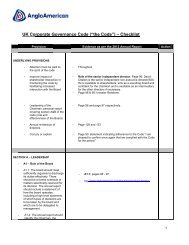Minas Rio Project - Anglo American
Minas Rio Project - Anglo American
Minas Rio Project - Anglo American
Create successful ePaper yourself
Turn your PDF publications into a flip-book with our unique Google optimized e-Paper software.
<strong>Anglo</strong> Ferrous Metals – <strong>Minas</strong> <strong>Rio</strong> <strong>Project</strong><br />
Investor Presentation – Brasilia<br />
7 October 2009
Cautionary statement<br />
Disclaimer: This presentation has been prepared by <strong>Anglo</strong> <strong>American</strong> plc (“<strong>Anglo</strong> <strong>American</strong>”) and comprises the written materials/slides for a presentation concerning<br />
<strong>Anglo</strong> <strong>American</strong>. By attending this presentation and/or reviewing the slides you agree to be bound by the following conditions.<br />
This presentation is for information purposes only and does not constitute an offer to sell or the solicitation of an offer to buy shares in <strong>Anglo</strong> <strong>American</strong>. Further, it does<br />
not constitute a recommendation by <strong>Anglo</strong> <strong>American</strong> or any other party to sell or buy shares in <strong>Anglo</strong> <strong>American</strong> or any other securities. All written or oral forward-looking<br />
statements attributable to <strong>Anglo</strong> <strong>American</strong> or persons acting on their behalf are qualified in their entirety by these cautionary statements.<br />
Forward-Looking Statements<br />
This presentation includes forward-looking statements. All statements other than statements of historical facts included in this presentation, including, without limitation,<br />
those regarding <strong>Anglo</strong> <strong>American</strong>’s financial position, business and acquisition strategy, plans and objectives of management for future operations (including development<br />
plans and objectives relating to <strong>Anglo</strong> <strong>American</strong>’s products, production forecasts and reserve and resource positions), are forward-looking statements. Exploration<br />
targets are conceptual in nature and mineral resources/ore reserves may not be discovered or defined. Such forward-looking statements involve known and unknown<br />
risks, uncertainties and other factors which may cause the actual results, performance or achievements of <strong>Anglo</strong> <strong>American</strong>, or industry results, to be materially different<br />
from any future results, performance or achievements expressed or implied by such forward-looking statements.<br />
Such forward-looking statements are based on numerous assumptions regarding <strong>Anglo</strong> <strong>American</strong>’s present and future business strategies and the environment in which<br />
<strong>Anglo</strong> <strong>American</strong> will operate in the future. Important factors that could cause <strong>Anglo</strong> <strong>American</strong>’s actual results, performance or achievements to differ materially from those<br />
in the forward-looking statements include, among others, levels of actual production during any period, levels of global demand and commodity market prices, mineral<br />
resource exploration and development capabilities, recovery rates and other operational capabilities, the availability of mining and processing equipment, the ability to<br />
produce and transport products profitably, the impact of foreign currency exchange rates on market prices and operating costs, the availability of sufficient credit, the<br />
effects of inflation, political uncertainty and economic conditions in relevant areas of the world, the actions of competitors, activities by governmental authorities such as<br />
changes in taxation or safety, health, environmental or other types of regulation in the countries where <strong>Anglo</strong> <strong>American</strong> operates, conflicts over land and resource<br />
ownership rights and such other risk factors identified in <strong>Anglo</strong> <strong>American</strong>’s most recent Annual Report. Forward-looking statements should, therefore, be construed in<br />
light of such risk factors and undue reliance should not be placed on forward-looking statements. These forward-looking statements speak only as of the date of this<br />
presentation. <strong>Anglo</strong> <strong>American</strong> expressly disclaims any obligation or undertaking (except as required by applicable law, the City Code on Takeovers and Mergers (the<br />
“Takeover Code”), the UK Listing Rules, the Disclosure and Transparency Rules of the Financial Services Authority, the Listings Requirements of the securities<br />
exchange of the JSE Limited in South Africa, the SWX Swiss Exchange, the Botswana Stock Exchange and the Namibian Stock Exchange and any other applicable<br />
regulations) to release publicly any updates or revisions to any forward-looking statement contained herein to reflect any change in <strong>Anglo</strong> <strong>American</strong>’s expectations with<br />
regard thereto or any change in events, conditions or circumstances on which any such statement is based.<br />
Nothing in this presentation should be interpreted to mean that future earnings per share of <strong>Anglo</strong> <strong>American</strong> will necessarily match or exceed its historical published<br />
earnings per share.<br />
No Investment Advice<br />
This presentation has been prepared without reference to your particular investment objectives, financial situation, taxation position and particular needs. It is important<br />
that you view this presentation in its entirety. If you are in any doubt in relation to these matters, you should consult your stockbroker, bank manager, solicitor,<br />
accountant, taxation adviser or other independent financial adviser (where applicable, as authorised under the Financial Services and Markets Act 2000 in the UK, or in<br />
South Africa, under the Financial Advisory and Intermediary Services Act 37 of 2002.).<br />
2
Presentation Outline<br />
1. Introduction to <strong>Anglo</strong> Ferrous Metals (AFM)<br />
Overview<br />
Management<br />
Business Profile<br />
Safety<br />
2. Iron Ore Market Overview<br />
Industry Fundamentals<br />
3. Iron Ore Operations<br />
Strategy<br />
Global Footprint<br />
Operational Overview<br />
4. <strong>Minas</strong> <strong>Rio</strong> Business Case<br />
5. <strong>Minas</strong> <strong>Rio</strong> System<br />
System Overview<br />
Management<br />
<strong>Project</strong> Highlights<br />
Costs and Expansion Potential<br />
3
Overview of <strong>Anglo</strong> Ferrous Metals<br />
AFM is poised to be a major player in the structurally attractive iron ore<br />
industry<br />
<strong>Anglo</strong> Ferrous Metals<br />
AFM has undergone<br />
significant restructuring over<br />
past five years to become a<br />
major player in the attractive<br />
iron ore industry<br />
Kumba Iron Ore (63%)<br />
Sishen Mine<br />
(74%)<br />
Thabazimbi<br />
Mine (74%)<br />
<strong>Anglo</strong> Ferrous Brazil<br />
(100%)<br />
<strong>Minas</strong> <strong>Rio</strong><br />
<strong>Project</strong> (100%)<br />
Amapa<br />
Mine/<strong>Project</strong><br />
(70%)<br />
Scaw Metals<br />
(74% - 100%)<br />
Samancor<br />
Manganese<br />
(40%)<br />
With the objective of owning<br />
long life, high quality, low<br />
cost, expandable mines and<br />
logistics assets<br />
Portfolio includes:<br />
Kumba Iron Ore<br />
<strong>Anglo</strong> Ferrous Brazil<br />
Scaw Metals<br />
Samancor<br />
4
Management team<br />
<strong>Anglo</strong> Ferrous Metals is building an integrated management team<br />
Philip Baum<br />
AFM CEO<br />
Craig<br />
Miller<br />
Chris<br />
Griffith<br />
Stephan<br />
Weber<br />
Norman<br />
Mbazima<br />
Dalton<br />
Nosé<br />
Bernie<br />
Pryor<br />
James<br />
Harman<br />
Timo<br />
Smit<br />
Sarah<br />
Louw<br />
CFO<br />
Kumba Iron Ore<br />
CEO<br />
AFB CEO<br />
SCAW CEO<br />
Special <strong>Project</strong>s<br />
Business<br />
Development<br />
Strategy<br />
Marketing<br />
HR &<br />
Communication<br />
5
Financial Profile<br />
<strong>Anglo</strong> Ferrous Metals’ importance to the <strong>Anglo</strong> <strong>American</strong> Group continues<br />
to increase<br />
Operating Profit<br />
(US$ Millions)<br />
3,500<br />
Operating profit for H1 2009 was $857M (40% of <strong>Anglo</strong>)<br />
Invest to grow business focused on carbon steel raw materials<br />
3,000<br />
2,500<br />
2,000<br />
Commodity price boom and portfolio<br />
reorganisation<br />
1,500<br />
1,000<br />
500<br />
0<br />
Diversified asset portfolio<br />
2001 2002 2003 2004 2005 2006 2007 2008 H1 2009<br />
Others<br />
Manganese<br />
Iron Ore<br />
Source: <strong>Anglo</strong> <strong>American</strong><br />
6
Iron Ore Growth Story<br />
<strong>Anglo</strong> <strong>American</strong>’s existing iron ore assets have the potential to produce in<br />
excess of 150Mtpa by 2016<br />
Current and Potential Iron Ore Production – 100%<br />
180<br />
Mtpa production<br />
160<br />
140<br />
120<br />
100<br />
80<br />
60<br />
40<br />
20<br />
0<br />
Conceptual<br />
<strong>Project</strong>s<br />
(SEP2,<br />
<strong>Minas</strong>-<strong>Rio</strong><br />
Expansion,<br />
Amapa<br />
Expansion, others)<br />
Approved<br />
<strong>Project</strong>s (Sishen South,<br />
<strong>Minas</strong>-<strong>Rio</strong>)<br />
<strong>Project</strong>s in<br />
Implementation (SEP, Amapa)<br />
Current Production<br />
<strong>Project</strong>s currently in implementation<br />
or approved will result in 80Mtpa<br />
production<br />
Conceptual projects could double<br />
this capacity to beyond 150Mtpa<br />
by 2016<br />
60% of current and potential<br />
production located in Brazil<br />
2004<br />
2005<br />
2006<br />
2007<br />
2008<br />
2009<br />
2010<br />
2011<br />
2012<br />
2013<br />
2014<br />
2015<br />
2016<br />
2017<br />
2018<br />
2019<br />
Source: <strong>Anglo</strong> <strong>American</strong><br />
7
Safety<br />
Our Number 1 priority<br />
<strong>Anglo</strong> Ferrous Metals Safety Summary<br />
60 % improvement in LTIFR despite a changing risk<br />
profile.<br />
Kumba’s Thabazimbi mine achieved two years LTI-free<br />
in September 2009.<br />
71 % of the 64 operating areas have achieved zero<br />
harm YTD.<br />
<strong>Anglo</strong> Ferrous Brazil Safety Summary<br />
6 million LTI free man-hours (132 days).<br />
99 % improvement in safety performance.<br />
51,838 hours safety training and 309 safety<br />
improvement actions.<br />
Three fatalities in 2009<br />
8
Presentation Outline<br />
1. Introduction to <strong>Anglo</strong> Ferrous Metals<br />
2. Iron Ore Market Overview<br />
Overview<br />
Management<br />
Business Profile<br />
Safety<br />
Industry Fundamentals<br />
3. Iron Ore Operations<br />
Strategy<br />
Global Footprint<br />
Operational Overview<br />
4. <strong>Minas</strong> <strong>Rio</strong> Business Case<br />
5. <strong>Minas</strong> <strong>Rio</strong> System<br />
System Overview<br />
Management<br />
<strong>Project</strong> Highlights<br />
Costs and Expansion Potential<br />
9
Strong Demand Growth<br />
Seaborne Iron Ore demand growth driven by BRIC urbanization—and<br />
China still has some way to go, as have other developing nations<br />
World Seaborne Iron Ore demand (2000–2013F)<br />
(Mt)<br />
1,200<br />
1,000<br />
800<br />
600<br />
400<br />
200<br />
0<br />
2008–2013F<br />
2013F<br />
CAGR<br />
9.4%<br />
2000–<br />
2008<br />
CAGR<br />
25.8%<br />
1.3%<br />
0.7%<br />
(0.8)%<br />
(0.3)%<br />
4.4%<br />
16.7%<br />
4.6% (0.7)%<br />
Demand for Seaborne Iron Ore has<br />
increased strongly as steel production<br />
has expanded in BRIC economies<br />
– From 2000–2008 crude steel production<br />
increased by almost 400Mtpa, mostly<br />
driven by Chinese growth<br />
China accounts for 51% of seaborne<br />
iron ore demand as of 2008,<br />
compared to 16% in 2000<br />
– Chinese Iron Ore imports expected to<br />
grow by 9.4% annually from 2008–2013<br />
2000<br />
2001<br />
2002<br />
2003<br />
2004<br />
2005<br />
2006<br />
2007<br />
2008<br />
2009<br />
2010<br />
2011<br />
2012<br />
2013<br />
RoW Middle East Europe Big 6 Japan, S. Korea, Taiwan China<br />
Source:<br />
CRU<br />
10
Attractive Fundamentals<br />
Iron Ore has been one of the most attractive commodities over the current<br />
cycle with benchmark prices quadrupling during the last decade<br />
Benchmark Iron Ore Fines Price<br />
(c/dltu), real 2009 terms<br />
160<br />
140<br />
120<br />
100<br />
80<br />
60<br />
40<br />
20<br />
0<br />
2000 2001 2002 2003 2004 2005 2006 2007 2008 2009<br />
Iron Ore prices have increased by 369%<br />
between 2003 and 2008<br />
Benchmark pricing system under pressure, with<br />
more active spot market, and gradual move<br />
towards index pricing<br />
Industry Returns 1<br />
ROCE %<br />
100<br />
80<br />
60<br />
40<br />
20<br />
40<br />
30<br />
20<br />
10<br />
($bn)<br />
Top Iron Ore producers Vale, <strong>Rio</strong> Tinto and<br />
BHP have generated attractive ROCEs over<br />
the cycle from iron ore<br />
0<br />
0<br />
2001 2002 2003 2004 2005 2006 2007 2008<br />
ROCE (LHS) EBIT (RHS) Capital Employed (RHS)<br />
Source: CRU, company reports<br />
(1) Based on <strong>Rio</strong> Tinto, Vale and BHP Billiton segmental reports<br />
(2) ROCE = EBIT / Average operating assets<br />
11
Key Industry Trends<br />
Global iron ore grades are declining due to diminishing availability of high<br />
grade resources<br />
Production vs. Fe grade (2000–2020)<br />
Global iron ore production (Mt)<br />
Source:<br />
3,500<br />
3,000<br />
2,500<br />
56%<br />
55%<br />
2,000<br />
54%<br />
1,500<br />
53%<br />
1,000<br />
500<br />
52%<br />
0<br />
51%<br />
2000 2002 2004 2006 2008 2010 2012 2014 2016 2018 2020<br />
Global iron ore production (Mt) Average grade of production<br />
AME<br />
Global Iron Ore Supply<br />
Proportion of Trade (%)<br />
100%<br />
80%<br />
60%<br />
40%<br />
20%<br />
0%<br />
2006 2008 2010 2012 2014 2016 2018 2020<br />
Fines PF.Conc Lump Pellet<br />
Source: AME<br />
Grade (Fe)<br />
Iron Ore grades are declining driven by<br />
– Increased production in low-grade regions<br />
– Lack of new supply from major<br />
producing regions<br />
Hence, the premiums applied to higherquality<br />
products are expected to appreciate<br />
A trend towards direct charge materials is<br />
expected globally<br />
– This will lead to increased pellet and lump<br />
demand<br />
– Given lump supply pipeline is limited<br />
compared to other iron ore products,<br />
increasing numbers of pellet plants will be<br />
constructed<br />
12
Supply Pressures<br />
Seaborne iron ore is a consolidated industry—and developing new sources<br />
of supply is highly capital intensive<br />
Capex Estimate—Greenfield Developments (1)<br />
<br />
The “Big Three” iron ore producers supply nearly<br />
70% of seaborne iron ore<br />
Serra Sul<br />
Simandou<br />
6,000<br />
11,297<br />
<br />
Large suppliers have curtailed output in the face of<br />
the recent downturn<br />
WA RGP 5<br />
5,647<br />
<br />
New supply from junior miners limited due to high<br />
capital intensity<br />
<strong>Minas</strong> <strong>Rio</strong> Phase I<br />
Maquine-Bau<br />
2,509<br />
3,543 3,627<br />
– Big Three own most large<br />
high-grade resources near existing bulk<br />
infrastructure corridors<br />
Brockman 4<br />
Corumba II<br />
2,153<br />
1,521<br />
Average: US$4.2 billion<br />
– Rail and port infrastructure crucial to<br />
feasibility and cost of project development<br />
Sishen South<br />
1,017<br />
<br />
New low cost high grade resources are<br />
increasingly rare<br />
0 2,000 4,000 6,000 8,000 10,000 12,000<br />
US$ billion<br />
Source: Company announcements<br />
(1) Approved Greenfield development projects of <strong>Rio</strong> Tinto, Vale, BHP Billiton and <strong>Anglo</strong> <strong>American</strong><br />
<br />
Estimated 80m tonnes of replacement ore needed<br />
annually (i.e. one fully developed <strong>Minas</strong> <strong>Rio</strong><br />
system)<br />
13
Presentation Outline<br />
1. Introduction to <strong>Anglo</strong> Ferrous Metals<br />
2. Iron Ore Market Overview<br />
Overview<br />
Management<br />
Business Profile<br />
Safety<br />
Industry Fundamentals<br />
3. Iron Ore Operations<br />
Strategy<br />
Global Footprint<br />
Operational Overview<br />
4. <strong>Minas</strong> <strong>Rio</strong> Business Case<br />
5. <strong>Minas</strong> <strong>Rio</strong> System<br />
System Overview<br />
Management<br />
<strong>Project</strong> Highlights<br />
Costs and Expansion Potential<br />
14
<strong>Anglo</strong> Iron Ore Strategy<br />
<strong>Anglo</strong>’s strategy is to supply premium, high quality iron ore products in the<br />
face of the declining quality of global iron ore supplies<br />
(Mt)<br />
Demand Growth for Iron Ore Products (2000–2013)<br />
1,200<br />
1,000<br />
800<br />
600<br />
2008–2013F<br />
2013F<br />
CAGR<br />
2000–2008<br />
2008<br />
17.9%<br />
CAGR<br />
5.7%<br />
13.6%<br />
3.8%<br />
3.0%<br />
7.0%<br />
Two key trends will support demand for premium<br />
iron ore products<br />
– Steelmakers shifting to larger blast furnaces and<br />
quality requirements for crude steel will increase<br />
– declining availability of high quality lump<br />
Kumba produces a leading quality lump<br />
– Well positioned to supply high-growth Middle East<br />
and Asia Pacific markets<br />
400<br />
5.2%<br />
– Geographically well positioned to supply to<br />
European steel markets where other lump supplies<br />
are expected to decline<br />
200<br />
10.4%<br />
<strong>Minas</strong> <strong>Rio</strong> captures the high growth pellet feed<br />
market with its premium product<br />
0<br />
2000<br />
2001<br />
Source: CRU<br />
2002<br />
2003<br />
2004<br />
2005<br />
2006<br />
2007<br />
2008<br />
2009<br />
2010<br />
2011<br />
Fines Lump Pellets Pellet Feed<br />
2012<br />
2013<br />
– high iron content and low impurities<br />
<strong>Anglo</strong> Ferrous Metals Marketing – blending<br />
opportunities and cross selling between Brazil<br />
and South Africa<br />
15
<strong>Anglo</strong> Iron Ore Strategy<br />
<strong>Minas</strong> <strong>Rio</strong> & Sishen are expected to be among the lowest cost in the<br />
industry, generating a substantial cash margin on high quality products<br />
FOB cost 1 , 2009 terms ($/t)<br />
Cost curve 2013<br />
120<br />
100<br />
80<br />
60<br />
40<br />
20<br />
Q1 Q2 Q3 Q4<br />
<strong>Minas</strong>-<strong>Rio</strong><br />
Sishen & Sishen South<br />
Sishen lump ore quality comparison<br />
Ore Fe % Tumbler Index 2 %<br />
Kumba 66.3% 93.0%<br />
Australian 64.9% 90.0%<br />
Brazilian 66.9% 79.7%<br />
Indian 63.0% 75.0%<br />
<strong>Minas</strong>-<strong>Rio</strong> pellet feed quality comparison<br />
Ore Fe % Alumina + Silica %<br />
<strong>Minas</strong> <strong>Rio</strong> >68%
<strong>Anglo</strong> Ferrous Metals Operational Footprint<br />
<strong>Anglo</strong> Ferrous has a unique iron ore resource footprint, with large, high<br />
quality resource bases in South Africa and Brazil<br />
South Africa<br />
Brazil<br />
1<br />
Sishenand<br />
SishenSouth<br />
Thabazimbi<br />
2<br />
<strong>Minas</strong> Gerais<br />
State<br />
1<br />
Amapá<br />
State<br />
2<br />
Santana<br />
Port<br />
Saldanha<br />
Port<br />
525km<br />
Slurry<br />
Pipeline<br />
<strong>Rio</strong> de Janeiro State<br />
Açu<br />
Port<br />
Kumba <strong>Minas</strong> <strong>Rio</strong> Amapá<br />
2008 production<br />
36.7 mt<br />
2013 Target Production 26.5 mtpa 2008 production<br />
1H09 production<br />
18 mt<br />
Potential Capacity >80 mtpa 1H09 production<br />
1H09 domestic sales<br />
2 mt<br />
Resources<br />
1H09 export sales<br />
17.1 mt<br />
4.6Bt<br />
Nameplate capacity<br />
Resources (excl. Reserves) 2.2 Bt Products Fe Content >68%<br />
Products<br />
Reserves<br />
1.2 Bt Products<br />
Pellet Feed, Fines<br />
Product Fe Content<br />
64–66% Slurry Pipeline 100% owned Logistics<br />
Products<br />
Fines, Lump Açu Port<br />
49% owned<br />
1.2 mt<br />
1.2 mt<br />
6.5 mtpa<br />
Pellet Feed,<br />
Fines<br />
Rail, Port<br />
17
Sishen – a World Class Asset<br />
Sishen produces one of the best premium lump products globally<br />
Quality of Global Lump Products<br />
Tumble index (1)<br />
100<br />
95<br />
90<br />
85<br />
80<br />
75<br />
<strong>Rio</strong> –<br />
Hope Downs<br />
<strong>Rio</strong>—West Angelas<br />
<strong>Rio</strong>—Hamersley<br />
Portman—<br />
Koolyanobbing<br />
BHP –<br />
Mt. Newman<br />
Vale—Carajas<br />
<strong>Anglo</strong>—Sishen<br />
Vale—Corumba<br />
Vale—MBR<br />
Lump is highly valued by steelmakers,<br />
as it can be fed directly into the<br />
blast furnace without the need for<br />
sintering or pelletizing<br />
Lump is a rare commodity, with high<br />
quality sources of lump on the decline<br />
Sishen has a 60% lump ratio, compared<br />
to ratios in the 30s and below for other<br />
producers<br />
Sesa Goa<br />
70<br />
60% 62% 64% 66% 68% 70%<br />
Iron content (%)<br />
Sishen’s lump is high-grade and<br />
exceptionally hard, allowing for selective<br />
sizing and premium pricing<br />
Australia Brazil India<br />
Source: CRU<br />
(1) A higher tumble index means higher physical strength, a desirable quality for lump ore<br />
(2) Bubble size indicates 2008 iron ore production<br />
18
Sishen – a World Class Asset<br />
FOB cost ($/t)<br />
Sishen is a world-class iron ore asset with a leading cash cost position,<br />
significant resources and scalable production profile<br />
FOB Iron Ore Cost Curve, 2008<br />
120<br />
100<br />
80<br />
60<br />
40<br />
20<br />
Sishen<br />
Q1 Q2 Q3 Q4<br />
0<br />
0 100 200 300 400 500 600 700 800 900 1,000<br />
Source: AME, <strong>Anglo</strong> <strong>American</strong> forecasts, CRU<br />
Cumulative production (Mt)<br />
<strong>Anglo</strong> has transformed Sishen into a<br />
world-class exporter of iron ore<br />
– Acquired 67% of Kumba in 2003 for US$1bn<br />
– Realised more than US$1bn in dividends and<br />
unbundling proceeds<br />
– Market value of Kumba Iron Ore stake of ~US$7.2bn 1<br />
Mine life of greater than 20 years<br />
Leading cash cost position<br />
Mt<br />
Sishen and Expansions Production Profile – 100%<br />
70<br />
60<br />
50<br />
40<br />
30<br />
20<br />
10<br />
0<br />
Concentrate<br />
SEP 1B<br />
SEP 2<br />
Sishen South<br />
Sishen Expansion <strong>Project</strong> (SEP)<br />
Sishen<br />
2004<br />
2005<br />
2006<br />
2007<br />
2008<br />
2009<br />
2010<br />
2011<br />
2012<br />
2013<br />
2014<br />
2015<br />
2016<br />
2017<br />
2018<br />
2019<br />
Approved projects<br />
Sishen Reserves/Resources (2)<br />
Mt<br />
2,000<br />
1,500<br />
1,000<br />
500<br />
0<br />
957<br />
248<br />
1,625<br />
151<br />
716<br />
709 759<br />
Proven<br />
Reserves<br />
Probable<br />
Resources<br />
Inferred<br />
Indicated<br />
Measured<br />
Source: Kumba Iron Ore, AME June 2009<br />
(1) Based on 62.76% stake of 320.4m shares with a market value of $11.5bn as<br />
of 28 September 2009<br />
(2) Excludes Sishen South Reserves of 214Mt and Resources of 153Mt<br />
19
Sishen South<br />
FOB cost (1) 2009 terms($/t)<br />
Mt<br />
10<br />
Sishen South <strong>Project</strong><br />
FOB Iron Ore Cost Curve 2013<br />
8<br />
6<br />
4<br />
2<br />
0<br />
Q1 Q2 Q3 Q4<br />
Sishen South<br />
Cumulative production (Mt)<br />
Sishen South Production Profile – 100%<br />
Sishen South<br />
2009<br />
2010<br />
2011<br />
2012<br />
2013<br />
2014<br />
2015<br />
2016<br />
2017<br />
2018<br />
2019<br />
(1) Includes royalty Source: AME, <strong>Anglo</strong> <strong>American</strong> forecasts, CRU<br />
2020<br />
Mt<br />
250<br />
200<br />
150<br />
100<br />
50<br />
Sishen South Reserves/Resources<br />
0<br />
One million man-hours achieved without an LTI<br />
<strong>Project</strong> continues, despite current market conditions,<br />
on time and on budget<br />
First production remains on schedule for 1H 2012, full<br />
production expected in 2013<br />
Nameplate capacity of 9Mtpa<br />
ZAR1.8 billion capital expenditure spent to date,<br />
ZAR3.6 billion contractually committed<br />
214<br />
91<br />
123<br />
Reserves<br />
Probable<br />
Proven<br />
Source: Kumba Iron Ore, AME June 2009<br />
* Resources in addition to Reserves<br />
153<br />
83<br />
21<br />
50<br />
Resources<br />
Inferred<br />
Indicated<br />
Measured<br />
20
Presentation Outline<br />
1. Introduction to <strong>Anglo</strong> Ferrous Metals<br />
2. Iron Ore Market Overview<br />
3. Iron Ore Operations<br />
Overview<br />
Management<br />
Business Profile<br />
Safety<br />
Industry Fundamentals<br />
Strategy<br />
Global Footprint<br />
Operational Overview<br />
4. <strong>Minas</strong> <strong>Rio</strong> Business Case<br />
5. <strong>Minas</strong> <strong>Rio</strong> System<br />
System Overview<br />
Management<br />
<strong>Project</strong> Highlights<br />
Costs and Expansion Potential<br />
21
Regional Supply Trends<br />
Brazil and Australia are the key iron ore growth regions – Given industry<br />
consolidation, there are few entry opportunities in Australia<br />
Global Iron Ore Seaborne Supply (2004–2008)<br />
950<br />
760<br />
570<br />
Brazil<br />
04-08<br />
CAGR<br />
2008<br />
Share<br />
13% 38%<br />
Brazil Advantages for <strong>Anglo</strong> Entry Point<br />
Highly cost advantaged (lowest FOB cost) due<br />
to high grades, water availability, logistics<br />
infrastructure, technology and low labor costs<br />
Large quality yet undeveloped iron ore reserves<br />
Socio-economic stability and internal demand<br />
growth<br />
380<br />
Australia<br />
12%<br />
37%<br />
Australia issues for <strong>Anglo</strong> Entry Point<br />
Most reserves already locked up by competitors<br />
190<br />
Others<br />
8% 12%<br />
Declining ore grades and higher impurities<br />
0<br />
2004 2008<br />
Source: Analyst reports<br />
India 4% 9%<br />
S. Africa 9% 4%<br />
Increased shipping capacity reduces freight<br />
differential<br />
22
<strong>Minas</strong> <strong>Rio</strong> Business Case<br />
Rationale for acquisition<br />
<br />
<br />
Iron ore is a structurally attractive market, in which <strong>Anglo</strong> has been looking to expand its<br />
presence for some time<br />
Tier one asset opportunities are rare<br />
<br />
<br />
<br />
<br />
Large long life resource<br />
Expandable<br />
Low cost with integrated logistics infrastructure<br />
High quality ore body<br />
<br />
<br />
<br />
<strong>Minas</strong> <strong>Rio</strong> ore has a complementary profile to <strong>Anglo</strong>’s current high quality Sishen ore<br />
product offer<br />
Acquired a large and experienced iron ore team<br />
<strong>Anglo</strong> has a significant footprint in the Brazilian market dating back over 30 years<br />
23
Presentation Outline<br />
1. Introduction to <strong>Anglo</strong> Ferrous Metals<br />
2. Iron Ore Market Overview<br />
3. Iron Ore Operations<br />
4. <strong>Minas</strong> <strong>Rio</strong> Business Case<br />
5. <strong>Minas</strong> <strong>Rio</strong> System<br />
System Overview<br />
Management<br />
<strong>Project</strong> Highlights<br />
1. Mine/Plant<br />
2. Pipeline<br />
3. Port<br />
Costs and Expansion Potential<br />
24
<strong>Minas</strong> <strong>Rio</strong> – a Major New Tier One Iron Ore <strong>Project</strong><br />
<strong>Minas</strong> <strong>Rio</strong> is a multi billion ton resource with its own logistics system and<br />
expansion potential to 80 million tons per year<br />
Pump Station<br />
Pipeline Construction, <strong>Minas</strong><br />
Gerais<br />
One of the world’s largest<br />
mining projects acquired by<br />
<strong>Anglo</strong> <strong>American</strong> in 2007 and<br />
2008<br />
525km<br />
Slurry<br />
Pipeline<br />
<strong>Minas</strong> Gerais<br />
State<br />
<strong>Rio</strong> de Janeiro State<br />
<br />
Açu Port<br />
Açú<br />
Port Construction<br />
Situated in an established<br />
iron ore mining area of Brazil<br />
<strong>Project</strong> consists of integrated<br />
mine, pipeline and port<br />
operations<br />
Current construction<br />
personnel of 4,500 peaking<br />
at 10,000 at height of work<br />
and 1,300 operational<br />
workforce once complete<br />
25
<strong>Anglo</strong> Ferrous Management Technical Expertise<br />
Highly experienced local senior management team with extensive support<br />
from <strong>Anglo</strong> Technical Division and <strong>Anglo</strong> Research Laboratories<br />
Stephan Weber<br />
AFB CEO<br />
<br />
23 years in Brazil and Australia, in leadership positions for iron ore and steel<br />
projects. Metallurgical Engineering graduate with last post at <strong>Rio</strong> Tinto<br />
Carlos Gonzales<br />
AFB COO<br />
<br />
15 years in mining industry, managing iron ore projects. Geological and<br />
Mining Engineering graduate with Strategic Management MBA with last post<br />
at Vale<br />
Stephen Hall<br />
<strong>Project</strong><br />
Director<br />
<br />
25 years experience managing major multi disciplinary projects internationally,<br />
within the Power, Iron & Steel, and Transportation sectors<br />
Fabio Lage<br />
MR Phase<br />
1 Director<br />
<br />
38 years managing large-scale engineering projects in extractive industries.<br />
Mechanical Engineering graduate. Last post at Vale (built Carajas system)<br />
Other highly experienced management includes:<br />
Daniel Santos, Sergio Botelho, Luis Patrus, Marcos Milo, Jose Zorman<br />
Integrated support structure from <strong>Anglo</strong> <strong>American</strong> plc<br />
Head of Processing<br />
Head of Mining<br />
Head of Engineering<br />
Main Activities with ATD:<br />
• <strong>Anglo</strong> Research - Amapa Process/Geology Review<br />
• <strong>Minas</strong> <strong>Rio</strong> Budget Review<br />
• Field Services - Engineering Support<br />
26
Process Flow<br />
<strong>Minas</strong> <strong>Rio</strong> ore is extracted and processed in the state of <strong>Minas</strong> Gerais and<br />
then transported as slurry to the Açú Port in the state of <strong>Rio</strong> de Janeiro<br />
Extracted from the<br />
ground<br />
Process to upgrade Fe<br />
content<br />
Ore slurry transported<br />
via pipeline<br />
Ore is dewatered for<br />
shipment<br />
Approximate Operating Cost (Estimate)<br />
US$3/t US$7/t US$2/t<br />
US$1/t<br />
Output Iron Grade<br />
40% Fe > 68% Fe<br />
27
Product Quality<br />
<strong>Minas</strong> <strong>Rio</strong> has the highest quality pellet feed ore in the market<br />
Brazil<br />
Alumina + Silica content (%)<br />
10<br />
<strong>Rio</strong> (Hamersley Iron) - Hamersley System<br />
<strong>Rio</strong> (Robe River) - Mesa J<br />
BHP - Yarrie<br />
8<br />
NMDC - Bailadila<br />
Fortescue - Cloud Break<br />
AA (Kumba) - Sishen<br />
<strong>Rio</strong> - Simandou (new project)<br />
BHP - Yandi<br />
AA (Kumba) - Thabazimbi<br />
Vale - Southeastern System<br />
6<br />
BHP - Area C<br />
<strong>Rio</strong> (Robe River) - West Angelas<br />
Lebedinsky GOK - Lebedinsky<br />
BHP - Mt. Newman<br />
<strong>Rio</strong> - Hope Downs<br />
4<br />
<strong>Rio</strong> (IOC) - Carol Lake<br />
Vale - Southern System<br />
Samarco (50% BHP 50% Vale) - Alegria<br />
AA - Amapa<br />
Australia<br />
Canada<br />
<strong>Anglo</strong> <strong>American</strong><br />
India<br />
China<br />
Russia<br />
Guinea<br />
10 Mt pa<br />
2<br />
Baotou Steel - Baiyun<br />
0<br />
56 58<br />
60<br />
Source: CRU Iron Ore Cost Service, <strong>Anglo</strong> <strong>American</strong>, BCG Analysis<br />
Vale - Northern System<br />
AA <strong>Minas</strong> <strong>Rio</strong> (Starting in 2012)<br />
62 64 66 68 70<br />
Iron content (%)<br />
28
Licensing Detail<br />
Required licensing to deliver project<br />
Main Licenses & Permits<br />
Mine/Plant<br />
Pipeline<br />
Port<br />
Landowner release (consents)<br />
2008-2010<br />
2008-2010<br />
N/A<br />
LP:Licença Prévia (Preliminary License)<br />
Dec 2008<br />
Aug 2007<br />
Dec 2006<br />
ASV: (Vegetation Suppression License)<br />
May 2009<br />
Early 2010<br />
N/A<br />
LI:Licença de Instalação (Instalation Permit)<br />
Early 2010<br />
Jul 2008<br />
May 2007<br />
Decreto de Lavra (Mining Permit)<br />
Early 2010<br />
N/A<br />
N/A<br />
LO:Licença de Operação (Operation License)<br />
2012<br />
2012<br />
2012<br />
29
<strong>Minas</strong> <strong>Rio</strong> <strong>Project</strong> Overview<br />
Tier one integrated iron ore project<br />
0km 100km 200km<br />
First production in 2012 with full ramp-up to<br />
26.5Mtpa in 2013<br />
Scaleable resource and infrastructure with<br />
potential to deliver additional 53Mtpa or more<br />
Benefiting from <strong>Anglo</strong>-owned integrated logistics<br />
solution through slurry pipeline and Açu port<br />
– Unit cost of transporting material by pipeline significantly<br />
lower than railing<br />
<strong>Anglo</strong> has significantly increased <strong>Minas</strong> <strong>Rio</strong>’s iron<br />
ore resource since the acquisition<br />
– 2007: 3.6Bt (1.3Bt friable, 2.3Bt compact itabirite)<br />
– 2008: 4.6Bt (1.8Bt friable, 2.8Bt compact itabirite)<br />
– Increased confidence in resource estimates due to bringing<br />
geological processes in line with <strong>Anglo</strong> standards<br />
– Exploration targets with significant upside<br />
<strong>Project</strong> implementation has progressed<br />
significantly<br />
– Port construction well advanced<br />
– Very good progress made in licensing<br />
– Beneficiation plant earthworks underway<br />
– More than 4,500 employees and contractors<br />
currently working<br />
30
Development Schedule<br />
<strong>Minas</strong> <strong>Rio</strong> targeting first ore shipment in mid-2012<br />
2009 2010 2011 2012<br />
1<br />
Mine and Plant<br />
Commissioning<br />
October 2011<br />
First Ore through Beneficiation Plant<br />
2<br />
Pipeline<br />
Commissioning<br />
May 2012<br />
First Ore through Pipeline<br />
3<br />
Filtration<br />
Port<br />
Commissioning<br />
Commissioning<br />
June 2012<br />
First Ore Shipment<br />
Source:<br />
<strong>Anglo</strong> <strong>American</strong><br />
31
Presentation Outline<br />
1. Introduction to <strong>Anglo</strong> Ferrous Metals<br />
2. Iron Ore Market Overview<br />
3. Iron Ore Operations<br />
4. <strong>Minas</strong> <strong>Rio</strong> Business Case<br />
5. <strong>Minas</strong> <strong>Rio</strong> System<br />
System Overview<br />
Management<br />
<strong>Project</strong> Highlights<br />
1. Mine/Plant<br />
2. Pipeline<br />
3. Port<br />
Costs and Expansion Potential<br />
32
1. <strong>Minas</strong> <strong>Rio</strong> Mine<br />
<strong>Minas</strong> <strong>Rio</strong> Mine<br />
Serro<br />
40km<br />
Located in <strong>Minas</strong> Gerais State, Brazil<br />
100% owned by <strong>Anglo</strong> Ferrous Brazil<br />
Brazil<br />
<strong>Minas</strong> Gerais State<br />
Belo Horizonte<br />
Itapa<br />
Serra do Sapo<br />
Iron Quadrangle<br />
<strong>Minas</strong>-<strong>Rio</strong> Deposits<br />
Joao Molevade<br />
Will be a major producer of high<br />
quality pellet feed with conventional<br />
open pit operation with a strip ratio of<br />
0.5 for first five years<br />
Phase 1 production expected to reach<br />
26.5Mtpa commencing in 2012<br />
Potential to expand production to<br />
80Mtpa<br />
Certified resource of 4.6Bt itabirite<br />
with exploration targets identified for<br />
up to 3Bt<br />
To be connected to Açu Port by<br />
525km pipeline<br />
Resources consists of three assets:<br />
Serro, Itapa and Serra do Sapo<br />
(largest ore body)<br />
33
1. <strong>Project</strong> Timeline<br />
Mine completion schedule<br />
<strong>Project</strong> Milestones<br />
Key Outstanding Items<br />
Major Achievements<br />
2009<br />
2010<br />
Ongoing drilling campaign<br />
and metallurgical testing and<br />
earthworks started<br />
Start of construction for mine,<br />
beneficiation plant, water<br />
extraction, tailings dam,<br />
electromechanical, etc<br />
Initial Installation License (LI)<br />
for Ph1<br />
Final LI for Ph1<br />
Full release of landowners at<br />
mine<br />
MG State Public Utility<br />
Decrees for:<br />
230KV transmission line<br />
to Beneficiation Plant<br />
Water Pipeline to<br />
Beneficiation Plant<br />
34.5KV transmission line<br />
to Pipeline Intake Station<br />
2011<br />
Construction completion and<br />
beneficiation plant<br />
commissioning<br />
First ore through plant<br />
Production ramp-up<br />
Operating license for Ph1<br />
(LO)<br />
AFB obtained 25 licenses in 9<br />
months (Aug ’08 to May ’09)<br />
in addition to MMX having<br />
obtained 18 licenses in 20<br />
months (from Dec ‘06 to July<br />
‘08)<br />
2012<br />
34
1. Mine site<br />
Construction is expected to commence in 2010 pending final licenses<br />
Mine site<br />
Drill rig at <strong>Minas</strong> <strong>Rio</strong><br />
35
1. <strong>Minas</strong> <strong>Rio</strong> Mine - Serra do Sapo<br />
Original topography with iron grade projection<br />
36
1. Drilling Program<br />
Over 100,000 meters have been drilled to date<br />
Drilling Program (Km drilled)<br />
Serra do Sapo - Drilling<br />
area in Q1<br />
Itapa - Drilling area in Q1/Q2<br />
50<br />
45<br />
40<br />
35<br />
30<br />
25<br />
20<br />
15<br />
10<br />
5<br />
0<br />
45<br />
32 31 30<br />
25<br />
21<br />
1<br />
'05 '06 '07 '08 '09 '10 '11<br />
<strong>Project</strong>ed<br />
37
1. Ore Types<br />
Ore types at <strong>Minas</strong> <strong>Rio</strong><br />
Friable Itabirite Semi Compact Itabirite Compact Itabirite<br />
Friable Itabirite has been extensively leached over millions of years which leads to<br />
higher Fe content, low processing energy consumption and easy removal of<br />
contaminants<br />
38
1. Resources<br />
<strong>Anglo</strong> Ferrous Brazil is achieving high confidence on resources and<br />
metallurgical quality<br />
Itabirite Resources (Mt) 2007 2008<br />
Mt Mt % Fe<br />
Friable: Measured and Indicated 483 1,297<br />
Friable: Inferred 831 560<br />
Total Friable (High and Low Grade) 1,314 1,857 37.8<br />
Compact (Measured + Indicated + Inferred) 2,344 2,719 30.7<br />
Total Measured + Indicated + Inferred 3,658 4,576 33.7<br />
Exploration Targets<br />
Ongoing drilling is testing areas with conceptual targets of up to<br />
3 Bt of itabirite mineralisation.<br />
Typical grades of itabirite mineralisation range from 30-40% Fe<br />
Excellent metallurgical<br />
recovery of ~82%<br />
Concentration<br />
increases Fe grade to<br />
an excellent level of<br />
~68%<br />
Currently certified<br />
resources of 4.6 Bt<br />
with significant<br />
additional potential.<br />
39
1. Mine Plan – Phase 1<br />
Pre-stripping -- March 2010 to September 2011<br />
40
1. Mine Plan – Phase 1<br />
First Five Year Plan -- Ramp-up October 2011 to May 2013<br />
41
1. Mine Plan – Phase 1<br />
First Five Year Plan -- Full Capacity June 2013 to December 2017<br />
42
1. Ore Quality – First Five Year Plan Sampling<br />
Sampling program results obtained in 2009 for the First Five Year Plan<br />
Five years program:<br />
-Blending of 4t<br />
samples from<br />
drillcore representing<br />
first five years ROM<br />
- Processing in pilot<br />
scale evaluating<br />
process behavior.<br />
Pilot Plant<br />
First five<br />
years pit<br />
<strong>Minas</strong> <strong>Rio</strong> Pilot Test “Pit Five Years sample”<br />
Mass<br />
Metallurgical<br />
Metalurgical<br />
Fe ROM<br />
Fe Conc<br />
SiO 2 ROM<br />
SiO 2<br />
Al 2 O 3<br />
Al 2 O 3<br />
P ROM<br />
P<br />
LOI<br />
LOI<br />
Recovery<br />
Recovery<br />
Conc<br />
ROM<br />
Conc<br />
Conc<br />
ROM<br />
Conc<br />
46,8 47 79,3<br />
40,14<br />
69,77 >69 39,80 40 0,83 0.8 1,25 1.3 0,22 0.2 0,018 0.02 0.02 0,015<br />
0,38 0.4 0,11 0.1<br />
43
1. Ore Quality – Global Sampling<br />
2009 results obtained from all <strong>Minas</strong> <strong>Rio</strong> sections<br />
Products<br />
Fe<br />
SiO 2<br />
Al 2 O 3<br />
P<br />
Mn<br />
TiO 2<br />
P.F.<br />
Ca<br />
Mg<br />
Global S.sapo sample<br />
68,5<br />
0,57<br />
0,19<br />
0,021<br />
0,053<br />
0,05<br />
0,19<br />
0,010<br />
0,06<br />
17 sections - global IF<br />
69,2<br />
0,29<br />
0,26<br />
0,015<br />
0,048<br />
0,08<br />
0,29<br />
0,023<br />
0,03<br />
17 sections - global ISC<br />
69,2<br />
0,95<br />
0,27<br />
0,017<br />
0,047<br />
0,03<br />
0,08<br />
0,021<br />
0,06<br />
% Minerals<br />
Hematite granular<br />
Specularite<br />
Hematite lobular<br />
others<br />
1,08<br />
3,04<br />
40,79<br />
55,09<br />
Global sample<br />
0,59<br />
2,08<br />
12,37<br />
10,64<br />
30,92<br />
34,76<br />
52,28 56,36 56,36<br />
17 sections study – IF global 17 sections study – ISC global<br />
44
1. Process Flow sheet<br />
Plant Capacity to Produce 26.5Mtpa of Pellet Feed<br />
Crushing<br />
Concentration<br />
Roller Press<br />
Tailing<br />
Thickener<br />
Primary<br />
Crushing<br />
(*)<br />
Primary<br />
Grinding<br />
Flotation<br />
Desliming<br />
Recovery Water<br />
Secondary Crushing<br />
and Screening<br />
Regrinding<br />
(**)<br />
Pipeline<br />
Stockpile<br />
Concentrate<br />
Thickener<br />
Filtering<br />
(*)<br />
2 Ball Mills<br />
(**)<br />
16 Vertmills<br />
45
Presentation Outline<br />
1. Introduction to <strong>Anglo</strong> Ferrous Metals<br />
2. Iron Ore Market Overview<br />
3. Iron Ore Operations<br />
4. <strong>Minas</strong> <strong>Rio</strong> Business Case<br />
5. <strong>Minas</strong> <strong>Rio</strong> System<br />
System Overview<br />
Management<br />
<strong>Project</strong> Highlights<br />
1. Mine/Plant<br />
2. Pipeline<br />
3. Port<br />
Costs and Expansion Potential<br />
46
2. <strong>Minas</strong> <strong>Rio</strong> Pipeline<br />
To be updated<br />
<strong>Minas</strong> <strong>Rio</strong> Pipeline<br />
Pipeline extension: 525Km,<br />
passing through 32<br />
municipal districts from<br />
<strong>Minas</strong> Gerais and <strong>Rio</strong> de<br />
Janeiro States<br />
Well tested logistics<br />
method in Brazil built by<br />
highly experienced local<br />
contractors<br />
Initial underground 26 inch<br />
pipeline with 26.5Mtpa<br />
capacity<br />
Slurry propelled by gravity<br />
and by two pump stations<br />
Developed in three<br />
spreads of ~180 km each<br />
(I, II, II)<br />
Sole use transfer corridor<br />
with room for expansion<br />
Lower capital and<br />
operating costs than rail<br />
alternative<br />
Construction personnel of<br />
1,700<br />
47
2. <strong>Project</strong> Timeline<br />
Pipeline completion schedule<br />
<strong>Project</strong> Milestones<br />
Key Outstanding Items<br />
Major Achievements<br />
2009<br />
2010<br />
Earthworks started<br />
Start of construction spread III<br />
& II<br />
Start of construction spread I<br />
Pump stations, electrical<br />
transmission and filtration plant<br />
construction<br />
Spread III landowners release<br />
Spread II ASV license<br />
Spread II landowners release<br />
Spread I landowners release<br />
Spread I ASV license<br />
ASV for Emergency Dam at<br />
Pump Station 2<br />
ASV for the 138 KV<br />
transmission line to Pump<br />
Station 2<br />
2011<br />
2012<br />
Commissioning<br />
First water through pipeline<br />
First ore through pipeline<br />
48
2. Pipeline Construction<br />
100% of the pipes have been acquired and delivered to sites along route<br />
Pump Station #2 Site<br />
Pipe Stockyard at Carmésia<br />
49
Presentation Outline<br />
1. Introduction to <strong>Anglo</strong> Ferrous Metals<br />
2. Iron Ore Market Overview<br />
3. Iron Ore Operations<br />
4. <strong>Minas</strong> <strong>Rio</strong> Business Case<br />
5. <strong>Minas</strong> <strong>Rio</strong> System<br />
System Overview<br />
Management<br />
<strong>Project</strong> Highlights<br />
1. Mine/Plant<br />
2. Pipeline<br />
3. Port<br />
Costs and Expansion Potential<br />
50
3. Açu Port<br />
Açu Port<br />
<strong>Minas</strong>-<strong>Rio</strong><br />
Mines<br />
Pipeline<br />
524 Km from Mines<br />
to Açu Port<br />
100% owned by LLX <strong>Minas</strong> <strong>Rio</strong> -<br />
49% <strong>Anglo</strong> Ferrous Brazil; 51% LLX<br />
Storage capacity: 2.5mt (>30 days<br />
Phase 1 mine production)<br />
524 Km<br />
Filtering<br />
Plant<br />
Stockyard<br />
Açu Port<br />
Administrative<br />
Offices<br />
Açu Port<br />
Loading: 10,000 tph<br />
Access bridge: 3,000m long<br />
Max vessel size: 250,000dwt<br />
(Capesize)<br />
Draft: 21m<br />
Sufficient land available to expand<br />
the port and/or downstream<br />
operations<br />
Construction personnel of 2,800<br />
51
3. <strong>Project</strong> Timeline<br />
Port completion schedule<br />
<strong>Project</strong> Milestones<br />
Key Outstanding Items<br />
Major Achievements<br />
2009<br />
2010<br />
2011<br />
Civil works and construction<br />
Road quarry<br />
Hydraulic landfill<br />
Access bridge<br />
Dredging<br />
Iron ore pier<br />
Shiploader<br />
Breakwater<br />
ASV for Açu landfill<br />
LI for offshore sand pit for<br />
landfill<br />
Decreto de Lavra for Açu<br />
Quarry<br />
Bridge built to ~2km offshore<br />
Dredging well advanced<br />
2012<br />
First ore on ship<br />
52
3. <strong>Project</strong> Construction<br />
Aerial view of port site<br />
Concurrent<br />
Berthing<br />
Future Iron Ore<br />
Stockyard: capacity<br />
2,500,000 tons<br />
Pre casting piles<br />
manufacturing area<br />
Concurrent<br />
Facilities<br />
Future area of the<br />
Filtering facilities:<br />
12 Larox filters<br />
Rock storage for the<br />
construction of the<br />
Breakwater for the<br />
Concurrent Berthing<br />
53
3. Dredging<br />
Dredging work is on schedule<br />
Highlights<br />
<br />
<br />
Being performed by SHANGHAI DREDGING COMPANY (SDC)<br />
Volume of 12,500,000 m 3 already executed<br />
The total volume to be executed is 18,000,000 m 3 .<br />
4<br />
-18,50<br />
2<br />
-18,50<br />
1<br />
-18,50<br />
-21,00<br />
3<br />
-18,50<br />
Accumulated Volume (m³)<br />
15.000.000<br />
13.000.000<br />
11.000.000<br />
9.000.000<br />
7.000.000<br />
5.000.000<br />
3.000.000<br />
1.000.000<br />
sep-08<br />
oct-08<br />
DREDGING VOLUMES [m³]<br />
nov-08<br />
dec-08<br />
jan-09<br />
feb-09<br />
mar-09<br />
Month<br />
apr-09<br />
may-09<br />
jun-09<br />
jul-09<br />
aug-09<br />
Acc. Volume Forecast<br />
Acc. Volume Executed<br />
54
3. Port Bridge<br />
Canti traveller driving the piles at axle 104<br />
~2 Km<br />
55
Presentation Outline<br />
1. Introduction to <strong>Anglo</strong> Ferrous Metals<br />
2. Iron Ore Market Overview<br />
3. Iron Ore Operations<br />
4. <strong>Minas</strong> <strong>Rio</strong> Business Case<br />
5. <strong>Minas</strong> <strong>Rio</strong> System<br />
System Overview<br />
Management<br />
<strong>Project</strong> Highlights<br />
1. Mine/Plant<br />
2. Pipeline<br />
3. Port<br />
Costs and Expansion Potential<br />
56
Operating and capital costs<br />
<strong>Minas</strong> <strong>Rio</strong> has expected Capex of US$3.6bn with Opex of US$13/t<br />
<strong>Minas</strong> <strong>Rio</strong> CAPEX<br />
US$m (nominal)<br />
<strong>Minas</strong> <strong>Rio</strong> OPEX<br />
US$/tonne (real 2008)<br />
4,000<br />
3,200<br />
2,400<br />
1,395<br />
1,179 3,627<br />
14<br />
12<br />
10<br />
8<br />
13<br />
SHEQ+SG&A<br />
Dewatering<br />
Pipeline<br />
1,600<br />
6<br />
Plant<br />
1,053<br />
4<br />
800<br />
2<br />
Mine<br />
0<br />
Spent Committed Uncomitted Total<br />
0<br />
<strong>Minas</strong> <strong>Rio</strong><br />
57
Operating and capital costs<br />
Compared to other suppliers, AFB has a strong position, with Q1 costs and<br />
exceptionally high chemical quality with the <strong>Minas</strong> <strong>Rio</strong> project<br />
Iron Ore Cost Curve 2013<br />
FOB cost 1 , 2009 terms ($/t)<br />
120<br />
100<br />
80<br />
60<br />
40<br />
20<br />
Q1 Q2 Q3 Q4<br />
<strong>Minas</strong>-<strong>Rio</strong><br />
Sishen & Sishen South<br />
0<br />
0 200 400 600 800 1,000 1,200 1,400 1,600<br />
Cumulative production (Mt)<br />
Source: CRU, AME, <strong>Anglo</strong> <strong>American</strong> forecasts for Sishen and <strong>Minas</strong>-<strong>Rio</strong><br />
Note (1): includes royalty<br />
58
Expansion potential<br />
<strong>Minas</strong> <strong>Rio</strong> has significant upside potential<br />
<br />
Pre-feasibility study under way<br />
<br />
+4 billion tonne known resource base plus large targets can<br />
support significant expansion<br />
<br />
Additional production potential of 53Mtpa or more<br />
<br />
Will maintain low operating cost through ownership of integrated<br />
logistics<br />
<br />
Potential for including partners in next expansion phase<br />
<br />
Expansion capex yet to be determined, but expect synergies<br />
through use of infrastructure built during initial phase<br />
59
Summary<br />
<br />
Highly experienced team<br />
<br />
First production in 2012 with full ramp-up to 26.5Mtpa in 2013 with<br />
significant expansion potential (53Mtpa plus)<br />
<br />
Benefits from <strong>Anglo</strong>-owned integrated logistics solution through slurry<br />
pipeline and Açu port<br />
<br />
<strong>Anglo</strong> has materially increased <strong>Minas</strong> <strong>Rio</strong>’s iron ore resource since<br />
<strong>Anglo</strong> took control of the project in late 2008<br />
<br />
Increased confidence in resource estimates due to bringing geological<br />
process in line with <strong>Anglo</strong> standards<br />
<br />
<strong>Project</strong> implementation has progressed significantly<br />
60



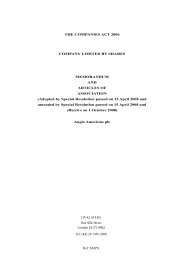
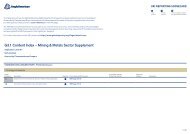
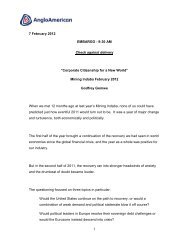
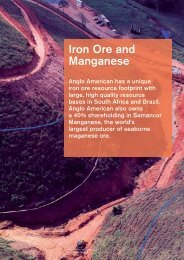
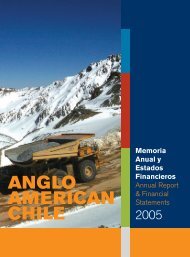
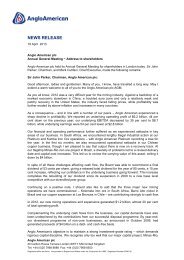
![English PDF [ 189KB ] - Anglo American](https://img.yumpu.com/50470814/1/184x260/english-pdf-189kb-anglo-american.jpg?quality=85)
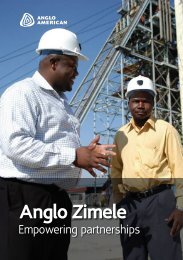

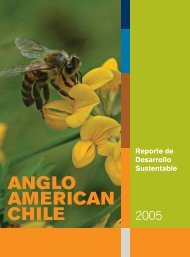

![pdf [ 595KB ] - Anglo American](https://img.yumpu.com/49420483/1/184x260/pdf-595kb-anglo-american.jpg?quality=85)
![pdf [ 1.1MB ] - Anglo American](https://img.yumpu.com/49057963/1/190x240/pdf-11mb-anglo-american.jpg?quality=85)
